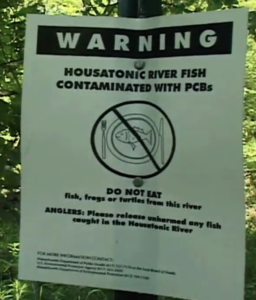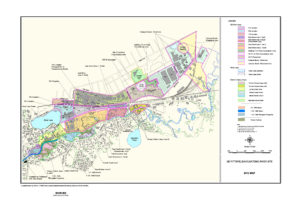The best starting place for a summary of the situation is our rebuttal of GE’s position on their contamination of the Housatonic River in Massachusetts.
From 1929 until 1977, when the EPA banned the use of PCBs, the General Electric Company (GE) in Pittsfield, Massachusetts used PCBs, a man-made toxic chemical, in the manufacture of its transformers. In the process, GE generated a lot of PCB waste in

A common sight along the Housatonic River.
Pittsfield, both in the normal course of manufacturing and in receiving old and damaged PCB-containing transformers. The evidence suggests that GE knew about the dangers of PCBs as early as 1937, and made a business decision to continue production and continue exposing its workers and ultimately the public to the harmful effects of PCBs.
In 1974, GE installed a thermal oxidizer to burn PCBs. It operated from 1974 to 1996.
“The former thermal oxidizer facility is located south of East Street, adjacent to the western limb of Former Oxbow H and the Housatonic River. The commercially run thermal oxidizer was operated to combust liquid PCB wastes. The facility began operations in 1974 and ceased operations in 1996 (EPA 1998). The liquid PCB wastes were transported to the facility and unloaded into several storage tanks. These PCB liquids were then transferred via a pipeline to the thermal oxidizer for incineration. As exhaust gas left the facility, water spray in the downcomer and a packed bed scrubber were used to remove hydrochloric acid (HCL) generated during the combustion process. Any remaining HCL in the water spray was then neutralized using a sodium hydroxide solution.” Public Health Assessment prepared by MA Dept. of Public Health (Sept. 2003)
From the website of the Housatonic River Initiative, interview with former GE employee Joe Carr regarding the thermal oxidizer:
“That thing was a hundred and some odd feet tall and there must have been two or three hundred rods in there that would measure what was coming out for smoke and so that they would either burn easier – it would tell them how fast they could burn stuff … and then I had a person I know from a government agency go up there and there were no rods in there. “They were all burned out – they used to burn it so hot and there were no rods to determine what the hell is all over Lakewood – all the smoke, all that stuff. We’re right here. And he finally … followed up through his agency and his agency finally came in and told them, that’s it, shut it down.”
In 1977, the Connecticut Department of Public Health issued a fish consumption advisory on most of the Housatonic River due to PCBs. The Massachusetts Department of Public Health followed in 1982. These advisories are still in effect.
In 1997, sampling of residential properties revealed that the soil of dozens of homes were contaminated with PCBs. EPA issued a request for all of GE’s documents and information related to its waste disposal practices.
The Housatonic River Initiative’s website quotes Ed Bates, former Manager of Tests at the Power Transformer division at GE in Pittsfield on the subject of Pyranol, GE’s name for its version of PCBs. “We used to use an average of 20,000 gallons of Pyranol a week and this is if you do simple mathematics, this is one hundred and forty thousand pounds of … PCBs a week that we were handling. And we had a loss rate: spillage, overfilling, of about 3% so this says that every week we would lose between four and five thousand pounds of PCBs that would go down into the drain and into the river. …About a million and a half pounds of PCBs have been plowed into that river. I imagine a good 30% is left.”
In August of 1997, EPA Regional Administrator John P. DeVillars, nominated the Housatonic River for Superfund status. In March of 1998, Mayor Gerald Doyle of Pittsfield announced his opposition to giving the Housatonic River Superfund status as he felt this would stigmatize Pittsfield. He further stated that GE Chairman Jack Welch had told him that should the site be given Superfund status Pittsfield would no longer be an appropriate home for GE Plastics World Headquarters.1 [Note: BEAT believes that since 1997, PCBs themselves have stigmatized Pittsfield, and that had the site been designated a Superfund Site, GE would have by now been made to clean the site at their company’s expense.]
So when you have a dangerous chemical such as PCB, how do you dispose of it? If you’re General Electric, you bury it on site and around the city. GE also dumped PCBs and other chemicals into Unkamet Brook and Silver Lake in Pittsfield, and when they still had more to get rid of, they offered it as fill to their neighbors, their own workers, the city, and even to their community schools.
According to the US Environmental Protection Agency, from the 1940s through the 1970s, GE gave away thousands of tons of contaminated fill from its facility to Pittsfield-area homeowners and contractors. GE’s PCBs have turned up in the backyards of former workers, in city parks and playgrounds, and even in city schoolyards. In the 1940s, the Army Corps of Engineers straightened much of the river in Pittsfield. This involved creating new channels, and filling in existing oxbows. The material they used was contaminated with PCBs from GE in Pittsfield.
In 1997, GE was ordered to remove 3,800 cubic yards of contaminated soil from a city playground, Dorothy Amos Park. The Park has been remediated, but the river bank and river next to the park still have high levels of PCBs.
GE was also ordered to remove fill from the schoolyard of the Allendale Elementary School. (This is the same school that now finds itself next to two toxic waste dumps, one of which is a high-level toxic waste dump, because when GE was ordered to remove contaminated sludge from the Housatonic River they piled it next to the school.) The evidence suggests that GE knew about the dangers as early as 1937.
- The Settlement, Berkshire Eagle (extra), 10/26/1998

